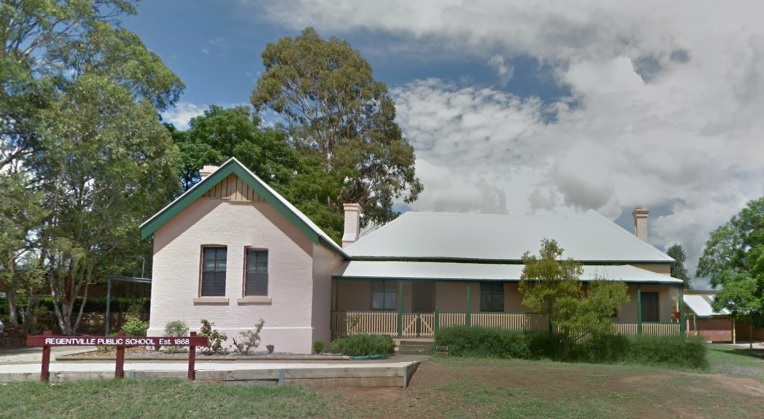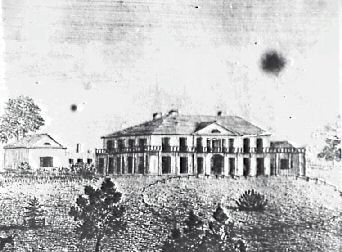Penrith City Local History - Places - Suburb profiles - Regentville
Regentville
Regentville is located east of the Nepean River, south of the M4 Motorway and north of the suburbs of Glenmore Park and Mulgoa. This small suburb had its historic beginnings with the arrival of Sir John Jamison and the development of his property Regentville. His many agricultural interests changed the landscape of the area with the construction of a tweed mill, the growing of grapes and the many small farms let out to mostly Irish tenants. Regentville today is a suburb of less than 1000 people, still very much a rural village, tucked away from the main stresses of city life.
Regentville on Google Maps.
Both Sir John Jamison and his father Thomas were naval surgeons, indeed Sir John had attended Lord Nelson’s wounds on the Victory during the Battle of Trafalgar in 1805. In 1808 he was sent, as part of a naval detachment, to the Baltic. His successful efforts to control scurvy in the Swedish navy through his introduction of a balanced diet, which included fruit and vegetables, led to the conferring of the Order of Gustavus Vasa on him by Charles XIII of Sweden.
When Sir John Jamison arrived in Australia in 1814, he inherited a large area of land along the Nepean River left to him by his father. Over the next few years he progressively added to this land, via grant and purchase. The actual site on which his villa was erected was on 600 acres purchased from the Reverend Robert Cartwright.
The stone for this impressive two-storey mansion was quarried on site and numerous service buildings and workers’ cottages were also built. The estate was extremely prosperous, with vineyards, livestock, orchards and a horse stud. From 1835 to 1840 a tweed mill was
erected on site.
Known as the “Hospitable Knight of Regentville”, Sir John Jamison was famous for his lavish entertainment. He was the inaugural president of the Agricultural Society of NSW, a founder of the Sydney Turf Club, and a member of many public societies. He was appointed as a member of the Legislative Council of New South Wales, a position he held from 1837 till 1843, the year before his death.
Unfortunately, Sir John Jamison was ruined in the depression of the 1840s. As a major shareholder in the Bank of Australia, formed in 1826, when the bank crashed in 1843, he was left bankrupt. At his death in 1844, his wife Mary and their six children were left with very few assets. Jamison did not marry Mary till just before his death in 1844. She had lived in the house as his ‘housekeeper’ for many years.
From this time onwards, the property deteriorated. The mansion was used for a short time as a mental asylum, but this venture failed. The mill manager is known to have lived in the house at some time, and it was leased by the Shiels family as a hotel from 1865. On 22 May, 1869 however, Regentville was burned to the ground. The inquest concluded that arson had taken place. Some of the stone blocks were then removed and used to build other houses in the area and as gutters in parts of Station and Belmore Streets in Penrith. The only part still remaining of this once great house is the spacious cellar.
The area around and including the small rural village of Regentville was gazetted as a suburb in 1970. For many years this suburb retained its rural atmosphere, but with the development of Glenmore Park to the south and east, during the 1990s, the country atmosphere has changed to a more suburban one.
Regentville Public School
A local school was established as early as 1868 on a site now known as School House Creek. No extant evidence of this building remains. Regentville Public School was built in 1881. The 1881 brick residence and classroom still stand on School House Road.

Photo by Google Maps
Regentville Workers Terrace
This building was originally row housing for Jamison’s woollen mill factory, being built in 1844. It was purchased by the Addicott family who renovated the building in the 1930s.

Photo by Google Maps
Regentville
Built by Sir John Jamison, in 1825. In the early 1860’s it was leased by Frederick Bell who opened the house as a private asylum. In 1865 John Shiels leased the property and established a family hotel and guesthouse. Regentville was destroyed by fire in 1869.

Regentville in ruins -1920s
| 1805 | Land grant of 1000 acres given to Thomas Jamison | |
| 1811 | Thomas Jamison dies in England, his properties pass to his son Sir John Jamison | |
| 1814 | 30 July | Sir John Jamison arrived in New South Wales on the Broxbornbury |
| 1819 | 31 August | Sir John Jamison received land grant of 460 acres at Regentville |
| 1823 | 11 September | Foundation stone laid for the building of Regent Villa, Sir John’s second home |
| 1844 | June | Sir John Jamison died and was buried at St Stephens Anglican Cemetery at Penrith |
| 1868 | October | A National School at Regentville granted |
| 1869 | 22 May | Regent Villa burned down |
| 1882 | March | A permanent brick building was erected for the school on land donated by Sir John Jamison’s son |
| 1969 | M4 bridge built over the Nepean River near Factory Road | |
| 1970 | Suburb of Regentville gazetted | |
| 1990 | July | University of Sydney undertook archaeological excavations at the site of Regentville |
| 1994 | April | University of Sydney undertook archaeological excavations at the site of Regentville |
